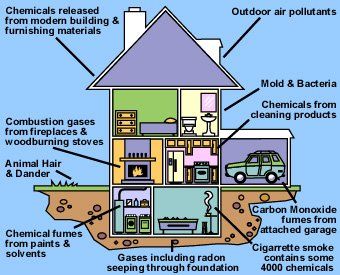
There are many factors that affect indoor air quality. Our primary focus is on the contaminants in water-damaged buildings. These contaminants include molds, mycotoxins, volatile organic compounds, microbial particulates, proteins, galactomannans, endotoxins and bacteria.
These water damage events can occur in connection with floods, hurricanes, construction defects, roof leaks, foundation problems, plumbing leaks, appliance leaks, condensation, or as a result of buildings materials that can become wet during storage, transportation and construction.
Some of the additional factors that affect indoor air quality include radon, lead, asbestos, pesticides, formaldehyde, carbon monoxide, cleaning products, off-gassing from carpets, fragrances, furniture and paint, dimethyl fumarate (DMF), air fresheners, electromagnetic fields (EMF) and radio frequency radiation (RF) and a wide variety of other toxins and chemicals.
Who is Affected
Poor indoor air quality affects people from all walks of life. Affected persons include both genders, all ages, those unborn and soon-to-be-born, homemakers, stay-at-home moms, teachers and school children, veterans, retirees, disabled individuals, workers of all levels and skills, farmers, professionals, owners of businesses large and small, and all degrees of affluence.
1989 Report from the Commonwealth of Massachusetts on Indoor Air Pollution
The 1989 report from the Commonwealth of Massachusetts on indoor air pollution states that sick building syndrome has been known since World War I, but the first published research paper on the topic did not happen until 1948 in England.
The report also acknowledged that health effects of biological contaminants can be due to allergenic, infectious or toxicogenic properties.
The following statements are excerpts from the Massachusetts report:
- Indoor air pollution is a growing problem in the United States and accounts for up to 50% of all illnesses.
- The indoor air we breathe often contains pollutants which may have health effects ranging from annoying to deadly. Major pollutant types found in indoor environments include tobacco smoke, radon gas, formaldehyde, asbestos, volatile organic compounds, pesticides, combustion products and biological contaminants.
- For most of these pollutants, concentrations measured indoors exceed levels found outdoors yet current environmental air pollution laws and regulations are not protective of these indoor environments. They focus instead on the outdoor environment even though individuals spend about ninety percent (90%) of their time indoors.
- Biological contamination of indoor environments ranks third in NIOSH's list of indoor air health threats after poor ventilation and building fabric contaminants. Types of biological contamination range from animal dander, pollen and dust to bacteria, fungi and viruses.
- Poor ventilation, stagnant water in ventilation systems, and relative humidity levels falling outside the 40-60% range have been implicated as causes of high indoor air concentrations of these biological contaminants. High humidity and moisture concentrations support proliferation of biologicals in ventilation systems.
- The Commission's efforts confirm the seriousness of the indoor air pollution health threat, which worsened with the energy conservation efforts of the 1970s. More insulation and tighter construction led to lower ventilation rates and build-up of contaminants.
- Many ‘sick’ buildings have been identified where occupants suffer severe or recurring discomforts such as headaches, dizziness, fatigue, eye irritation, and respiratory problems. Other conditions attributable to indoor air contaminants include: cancer; bronchitis; pneumonia; heart, circulatory and respiratory problems; impaired vision; skin rash; chemical sensitivity; birth defects; and mental, nervous and immunological disorders.




